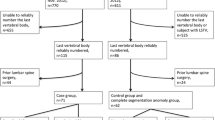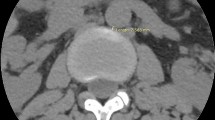Abstract.
The objective of this study was to determine the level of the aortic bifurcation in relation to the lumbar spine by MRI and the effect of lumbosacral anomalies on the aortic bifurcation. A prospective study of 441 patients was performed. Sagittal MR images of the entire spine were obtained along with the standard protocol for imaging of the lumbar spine. The vertebrae were counted caudally from C2 instead of cranially from the presumed L5 vertebra. The aortic bifurcation in relation to the lumbar vertebrae was determined. The aorta bifurcated at the L4 vertebral body in 67% of cases. In patients with sacralization of L5 the aortic bifurcation was at the L3 vertebral body in 59%. In those patients with lumbarization of S1 the aorta bifurcated at the level of the L4 vertebral body in 40% and at the L4/5 disc space in 33%. There was no demographic variation of the aortic bifurcation in relation to age or sex. The aorta bifurcated at L4 in two-thirds of cases and was variably located in the remaining third. The stability of this as a landmark is disturbed by the significant high incidence of lumbosacral transitional segments. The French version of this article is available in the form of electronic supplementary material and can be obtained by using the Springer LINK server located at http://dx.doi.org/10.1007/s00276-002-0036-3.
Résumé.
L'objectif de ce travail était de déterminer par imagerie par résonance nucléaire (IRM) le niveau de la bifurcation aortique par rapport aux vertèbres lombales et d'étudier l'effet des anomalies transitionnelles lombo-sacrées sur celui-ci. Une étude prospective de 441 patients a été réalisée. Des coupes IRM sagittales de l'ensemble du rachis ont été effectuées en complément d'un protocole standard d'imagerie du rachis lombal. Les vertèbres ont été comptées dans le sens crânio-caudal à partir de C2 et non dans le sens caudo-crânial à partir de la vertèbre présumée L5. La situation de la bifurcation aortique par rapport aux vertèbres lombales a alors été déterminée. Dans 67% des cas, elle siégeait en regard du corps vertébral de L4. En cas de sacralisation de L5, elle était observée en regard de L3 dans 59% des cas. Lorsqu'il existait une lombalisation de S1, elle se projetait au niveau du corps vertébral de L4 dans 40% des cas et au niveau du disque L4–L5 dans 33% des cas. Il n'a pas été observé de variation du niveau de la bifurcation aortique en fonction de l'âge et du sexe. La bifurcation aortique siégeait donc en regard de L4 dans deux tiers des cas et sa localisation était variable dans le tiers restant. Ce repère anatomique peut en particulier être modifié par les anomalies transitionnelles lombo-sacrées, qui sont d'observation fréquente.
Similar content being viewed by others
Author information
Authors and Affiliations
Additional information
Electronic Publication
Rights and permissions
About this article
Cite this article
Chithriki, .M., Jaibaji, .M. & Steele, .R. The anatomical relationship of the aortic bifurcation to the lumbar vertebrae: a MRI study. Surg Radiol Anat 24, 308–312 (2002). https://doi.org/10.1007/s00276-002-0036-3
Received:
Accepted:
Issue Date:
DOI: https://doi.org/10.1007/s00276-002-0036-3




